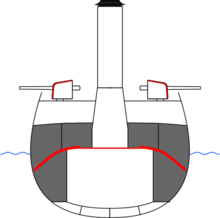Protected cruiser
A protected cruiser was a type of warship that was used from around 1880. In these cruisers , the armor protection consisted essentially of an armored deck, which protected the boiler and machine rooms as well as the ammunition chambers. The term “protected cruiser” is therefore largely used synonymously with that of the armored deck cruiser . Protected cruisers were less heavily armored than the later armored cruisers , which also had side armor .
description
Protected cruisers were initially provided with armor protection for the boiler and engine rooms and the main armament against the effects of enemy fire. Later versions were provided with a continuous armored deck and then also referred to as armored deck cruiser . In addition, the command post received armor protection. The British screw-powered corvette Comus , which was given a partial armored deck in 1879, is considered the first protected cruiser . The first through armored deck was used on the Chilean Armstrong Rendel cruiser Esmeralda in 1883 . The first protected cruiser of the Imperial Navy was SMS Gazelle
The thickness of the armored deck was mostly about 5 to 7.5 cm. The ship size usually varied from 2,500 to 7,000 tons . The main armament was different in the individual navies, but mostly consisted of up to twelve individual guns with 10 to 15 cm caliber. Some ships also carried a heavier gun (caliber 21 to 28 cm) on the fore and aft and resembled armored cruisers. Around 1900, protected cruisers with their piston steam engines typically reached speeds of 20 to 22 knots .
In the German Imperial Navy , from around 1900, an unofficial distinction was made between large protected cruisers (over 5000 t of water displacement) and small protected cruisers . After the First World War the designation “protected cruiser” was given up.
After 1900 until the First World War, only Germany and Great Britain built protected cruisers on a larger scale, namely those of the smaller type with an initial displacement of approx. 3000 t, which later grew to approx. 5000 t. These ships were used both overseas and for reconnaissance for the fleet. From 1907, turbines began to replace the triple expansion machines as a drive. In 1911, Germany and England began protecting their newest cruisers with additional armor belts 60–100 mm thick. With the SMS Admiral Spaun (1909) and the 3 ships of the Helgoland class (from 1912) Austria also built 3500 t modern cruisers with turbine drives and waterline tanks (see Rapidkreuzer ).
These ships, which strictly speaking were no longer protected cruisers, showed the development towards the light and heavy cruisers of the post-war period.
Received ships
A few protected cruisers have been preserved as museum ships to this day:
- Zr. Ms. Bonaire - Delfzijl , The Netherlands
- USS Olympia - Philadelphia , USA
- RN Puglia - Il Vittoriale in Gardone Riviera , Italy (bow section and bridge only)
- The Russian Aurora in Saint Petersburg is not an armored cruiser, contrary to what is stated in the English-language literature in particular.
photos
USS Olympia (C-6, 1892) as a museum ship in Philadelphia
Aurora as a museum ship in Saint Petersburg
Chikuma (Japan, 1911)
See also
literature
- Meyer's Large Conversation Lexicon . 6th edition. Bibliographisches Institut, Leipzig / Vienna 1909 ( zeno.org [accessed on May 15, 2019] Lexicon entry “Kreuzer”; therein “Large protected cruisers” and “Small protected cruisers”).
Individual evidence
- ^ Maritime dictionary. Compiled by Jürgen Gebauer and Egon Krenz. Military Publishing House of the German Democratic Republic, Berlin 1989, ISBN 3-327-00679-2 , p. 80.









